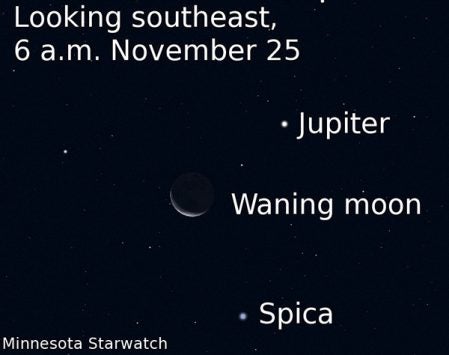Starwatch: Moon makes closest approach
Published 7:01 am Sunday, October 30, 2016
By Deane Morrison
Minnesota Starwatch
November may not be the sunniest month, but this time around it brings us the biggest and brightest full moon of the year.
On Monday, the 14th, the “beaver moon” passes perigee—its closest approach to Earth in a lunar cycle—just two and a half hours before reaching perfect fullness at 7:52 a.m. Astronomers call such a moon a perigee full moon, but these days it’s also known as a supermoon. At this perigee, the moon will be 221,529 miles from Earth. November’s full moon is the closest since 1948, and won’t be this close again until 2034.
 The downside is that all over Minnesota, the moon sets in the predawn hour, before the instant of fullness. But no worries; it will still be big and round through the night of the 13th-14th. To see it at its roundest, check your local time of moonset on the 14th and look to the west at least a half hour beforehand. The more obstructed your view of the western horizon, the earlier you’ll have to get up.
The downside is that all over Minnesota, the moon sets in the predawn hour, before the instant of fullness. But no worries; it will still be big and round through the night of the 13th-14th. To see it at its roundest, check your local time of moonset on the 14th and look to the west at least a half hour beforehand. The more obstructed your view of the western horizon, the earlier you’ll have to get up.
Nice as this moon may be when full, when waning it spoils the Leonid meteor shower. This sometimes spectacular shower peaks in the predawn hours of the 17th, when a thinner but still bright moon will wash out the fainter meteors. But you may catch some of the brighter ones radiating from a point high in the southeast, inside the head of Leo, the lion.
The moon makes partial amends on the morning of the 25th, when its waning crescent rises between bright Jupiter and Spica, the jewel of Virgo, in the east-southeast. Look for them about 40 minutes before sunrise. The bright star off to the left is Arcturus, in Bootes, the herdsman.
In the evening sky, Venus hugs the southwest horizon after sunset, while Mars glimmers in the south. Enjoy the Great Square of Pegasus as it climbs higher in the southeast from night to night. Late in the evening, watch Orion and other bright winter constellations follow the winged horse into the sky. At least some of the winter stars will still be shining, although now over to the west, if you get up early to admire Jupiter.


